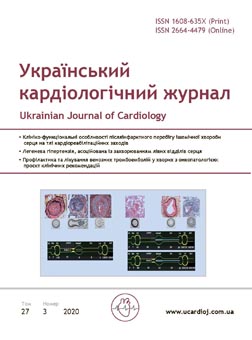TRIUMF-3: antihypertensive therapy in Ukraine – optimization of blood pressure in focus. The use of a triple fixed combination of antihypertensive drugs in the practice of a family doctor
Main Article Content
Abstract
The aim – to investigate the profile of patients with the uncontrolled arterial hypertension who concomitantly take two or three antihypertensive products and to evaluate the results of BP control achievement in this population after therapy adjustment.
Materials and methods. A total of 4113 patients with hypertension were invited to take part in TRIUMF-3 (antihypertensive therapy in Ukraine – optimization of blood pressure in focus) study, they were under the supervision of family doctors. Anamnestically all participants (average age – 64; 36.1 % – are men), at least 1 month before the study, took 2 or 3 antihypertensive drugs without sufficient effect. The average values of office BP were 172/99 mm Hg, in > 40 % of patients they exceeded 180/110 mm Hg. The drug of choice for further therapy for 4103 participants was fixed combination of perindopril arginine, amlodipine and indapamide – «Triplixam» (Servier, France). The follow-up period for each patient was 3 months. Patients visited doctors after 1-2 weeks, 2 and 3 months after the start of the study and the corresponding correction of therapy. Before and after 2 months, the indicator of adherence to treatment was assessed. The last analysis included a comparison of the results of TRIUMF-3 and TRIUMF-2 with patients who were under outpatient supervision by family doctors and cardiologists.
Results and discussion. The prescription of the original triple fixed combination for 3 months was allowed by the gradually decrease of BP to ~ 130/80 mm Hg; SBP (systolic BP) on average by ~ 42, DBP (diastolic BP) – by ~ 19 mm Hg. Target levels: < 140/90 mm Hg reached 73.4 % of patients, and ≤ 130/80 mm Hg – 59.1 %. In most patients (70 %) during the study, the rate of high adherence to treatment increased from an average of 9.5 % to 46.4 %. Triple fixed combination of perindopril arginine, indapamide and amlodipine therapy was well tolerated.
Conclusions. The use of an original triple fixed combination of perindopril arginine, indapamide and amlodipine by family doctors was accompanied by the achievement of target BP levels in more than 2/3 of patients with hypertension in whom the previous two- or three-component therapy was ineffective. The use of triple fixed combination of perindopril arginine, indapamide and amlodipine was effective in both groups of patients with hypertension observed in family doctors (TRIUMF-3) and cardiologists (TRIUMF-2). However, cardiologists used the largest doses of the drug almost twice as often, which led to more optimal BP control (≤ 130/80 mm Hg) in a larger group of patients: 69.7 % vs. 59.1 % in family doctors. Regular drug monitoring, antihypertensive efficacy, and ease of administration of a triple fixed combination of perindopril arginine, indapamide and amlodipine were likely to be determinants of increased adherence to treatment in most participants in both studies, 75 % to TRIUMF-2, and 70 % to TRIUMF-3. Moreover, the rate of high adherence during the 2-months follow-up period increased in both studies by almost 5 times.
Article Details
Keywords:
References
Коваленко В.М., Корнацький В.М., Манойленко Т.С. та ін. Проблеми здоров’я і медичної допомоги та модель покращання в сучасних умовах (посібник).– К., 2016.– С. 261.
Лутай М.І., Лисенко Г.Ф., учасники дослідження ТРІУМФ-2. Лікування артеріальної гіпертензії фіксованою комбінацією інгібітора ангіотензинперетворювального ферменту, блокатора кальцієвих каналів і тіазидоподібного діуретика. Результати українського багатоцентрового дослідження ТРІУМФ-2 // Укр. кардіол. журн.– 2017.– № 4.– С. 16–31.
Серцево-судинні захворювання. Класифікація, стандарти діагностики та лікування. Асоціація кардіологів України / За ред. В.M. Коваленка, М.І. Лутая, Ю.М. Сіренка, О.С. Сичова.– К.: Моріон, 2018.
Burnier M., Brown R.E., Ong S.H. et al. Issues in blood pressure control and the potential role of single-pill combination therapies // Int. J. Clin. Pract.– 2009.– Vol. 63 (5).– P. 790–798. doi: https://doi.org/10.1111/j.1742-1241.2009.01999.x.
Carvalho A.S., Santos P. Medication adherence in patients with arterial hypertension: The Relationship With Healthcare Systems’ Organizational Factors // Published online.– – Oct 17. doi: https://doi.org/10.2147/PPA.S216091.
Chalmers J., Arima H., Woodward M. et al. Effects of combination of perindopril, indapamide, and calcium channel blockers in patients with type 2 diabetes mellitus: results from the Action In Diabetes and Vascular Disease: Preterax and Diamicron Controlled Evaluation (ADVANCE) trial // Hypertension.– 2014.– Vol. 63 (2).– P. 259–264. doi: https://doi.org/10.1161/HYPERTENSIONAHA.113.02252.
Czernichow S., Zanchetti A., Turnbull F. et al. The effects of blood pressure reduction and of different blood pressure-lowering regimens on major cardiovascular events according to baseline blood pressure: meta-analysis of randomized trials // J. Hypertens.– 2011.– Vol. 29.– P. 4–16. doi: https://doi.org/10.1097/HJH.0b013e32834000be.
ESC/ESH Guidelines for the management of arterial hypertension: The Task Force for the management of arterial hypertension of the European Society of Cardiology (ESC) and the European Society of Hypertension (ESH) // Eur. Heart J.– 2018.– Vol. 39.– P. 3021–3104.
Jaffe M.G., Lee G.A., Young J.D. et al. Improved blood pressure control associated with a large‐scale hypertension program // JAMA.– 2013.– Vol. 310 (7).– P. 699–705. doi: https://doi.org/10.1001/jama.2013.108769.
Kishore S.P., Salam A., Rodgers A. et al. Fixed-Dose Combinations for Hypertension // Lancet.– 2018.– Vol. 392 (10150).– P. 819–820. doi: https://doi.org/10.1016/S0140-6736(18)31814-2.
Xie L., Frech-Tamas F., Marrett E., Baser O. A medication adherence and persistence comparison of hypertensive patients treated with single-, double- and triple-pill combination therapy // Curr. Med. Res. Opin.– 2014.– Vol. 26.– P. 2415–2422. doi:https://doi.org/ 10.1185/03007995.2014.964853.

